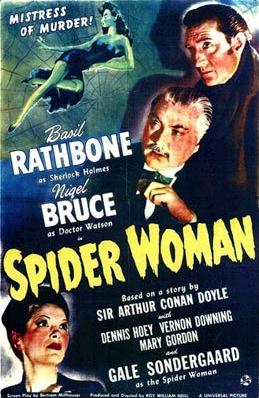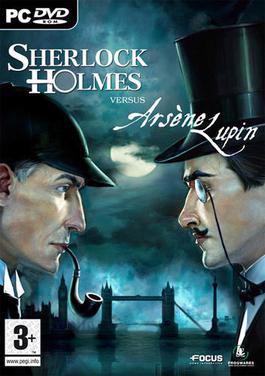
A Study in Scarlet is an 1887 detective novel by British writer Arthur Conan Doyle. The story marks the first appearance of Sherlock Holmes and Dr. Watson, who would become the most famous detective duo in English literature. The book's title derives from a speech given by Holmes, a consulting detective, to his friend and chronicler Watson on the nature of his work, in which he describes the story's murder investigation as his "study in scarlet": "There's the scarlet thread of murder running through the colourless skein of life, and our duty is to unravel it, and isolate it, and expose every inch of it."

"The Adventure of the Bruce-Partington Plans" is one of the 56 Sherlock Holmes short stories written by Sir Arthur Conan Doyle. It is one of eight stories in the cycle collected as His Last Bow (1917), and is the second and final main appearance of Mycroft Holmes. It was originally published in The Strand Magazine in the United Kingdom and in Collier's in the United States in 1908.

Sherlock Holmes in the 22nd Century is an animated television series in which Sherlock Holmes is brought back to life in the 22nd century. The series is a co-production by DIC Entertainment, L.P. and Scottish Television Enterprises and was nominated for a Daytime Emmy for Special Class Animated Program.

Detective Inspector G. Lestrade, or Mr. Lestrade, is a fictional character appearing in several of the Sherlock Holmes stories written by Arthur Conan Doyle. Lestrade's first appearance was in the first Sherlock Holmes story, the novel A Study in Scarlet, which was published in 1887. The last story in which he appears is the short story "The Adventure of the Three Garridebs", which was first published in 1924 and was included in the final collection of Sherlock Holmes stories by Doyle, The Case-Book of Sherlock Holmes.

"The Adventure of the Norwood Builder", one of the 56 short Sherlock Holmes stories written by Sir Arthur Conan Doyle, is the second tale from The Return of Sherlock Holmes. The story was first published in Collier's (US) on 31 October 1903 and in The Strand Magazine (UK) in November 1903.

The Hobbit is an illustrated text adventure computer game released in 1982 for the ZX Spectrum home computer and based on the 1937 book The Hobbit, by J. R. R. Tolkien. It was developed at Beam Software by Philip Mitchell and Veronika Megler and published by Melbourne House. It was later converted to most home computers available at the time including the Commodore 64, BBC Micro, and Oric computers. By arrangement with the book publishers, a copy of the book was included with each game sold.

Sherlock Holmes: Consulting Detective is a full-motion video game released in 1991. It is based on a tabletop game-gamebook hybrid of the same name first published in 1981, and features the fictional detective Sherlock Holmes, created by Arthur Conan Doyle.

Sherlock Holmes is the overall title given to the series of Sherlock Holmes adaptations produced by the British television company Granada Television between 24 April 1984 and 11 April 1994.
Sherlock Holmes has long been a popular character for pastiche, Holmes-related work by authors and creators other than Arthur Conan Doyle. Their works can be grouped into four broad categories:

Terror by Night is a 1946 Sherlock Holmes crime drama directed by Roy William Neill and starring Basil Rathbone and Nigel Bruce. The story revolves around the theft of a famous diamond aboard a train.

The Spider Woman is a 1943 mystery film starring Basil Rathbone as Sherlock Holmes and Nigel Bruce as Dr. Watson, the seventh of fourteen such films the pair were involved in. As with all of the Universal Studios films in the series, the film is set in then-present day as opposed to the Victorian setting of the original stories. This film incorporates elements from the 1890 novel The Sign of the Four, as well as the short stories "The Final Problem", "The Adventure of the Empty House", "The Adventure of the Speckled Band" and makes explicit reference to "The Adventure of the Devil's Foot".

The Lost Files of Sherlock Holmes is an adventure game developed by Mythos Software and published by Electronic Arts for MS-DOS in 1992 and 3DO in 1994. A sequel was developed and published by the same respective companies in 1996 titled The Lost Files of Sherlock Holmes: The Case of the Rose Tattoo.

The Lost Files of Sherlock Holmes: The Case of the Rose Tattoo is a graphic adventure game developed by Mythos Software and published by Electronic Arts in 1996. It features the fictional detective Sherlock Holmes created by Arthur Conan Doyle. The game is a sequel to The Lost Files of Sherlock Holmes: The Case of the Serrated Scalpel.

Sherlock Holmes Versus Arsène Lupin is an adventure game developed by Frogwares. The fourth game in the Sherlock Holmes series, it was released in October 2007 and is distributed by Focus Home Interactive. It was preceded in 2002 by Sherlock Holmes: The Mystery of the Mummy, in 2004 by Sherlock Holmes: The Case of the Silver Earring and in 2007 by Sherlock Holmes: The Awakened.

Sherlock Holmes and the Secret Weapon (1942) is the fourth in the Basil Rathbone/Nigel Bruce series of 14 Sherlock Holmes films which updated the characters created by Sir Arthur Conan Doyle to the then present day. The film is credited as an adaptation of Conan Doyle's 1903 short story "The Adventure of the Dancing Men," though the only element from the source material is the dancing men code. Rather, it is a spy film taking place on the background of the then ongoing Second World War with an original premise. The film concerns the kidnapping of a Swiss scientist by their nemesis Professor Moriarty, to steal a new bomb sight and sell it to Nazi Germany. Sherlock Holmes and Dr. John Watson have to crack a secret code in order to save the country.

Sherlock Holmes Faces Death is the sixth film in the Basil Rathbone/Nigel Bruce series of Sherlock Holmes films. Made in 1943, it is a loose adaptation of Sir Arthur Conan Doyle's 1893 Holmes short story "The Adventure of the Musgrave Ritual". Its three immediate predecessors in the film series were World War II spy adventures with Holmes and Dr. Watson helping the Allies thwart enemy agents, but this one marked a return to the pure mystery film form. Though several characters are military men and there are frequent mentions of the ongoing war, it is not the focus of the story.

Sherlock Holmes: Consulting Detective Vol. III is the title of a full-motion video computer game released for DOS and Mac OS. The game is a sequel to Sherlock Holmes: Consulting Detective Vol. II and was released in 1993.

Sir Arthur Conan Doyle's Sherlock Holmes, also known simply as Sherlock Holmes, is a 2010 British-American steampunk mystery film directed by Rachel Lee Goldenberg and produced by independent American film studio The Asylum. It features the Sherlock Holmes characters created by Sir Arthur Conan Doyle, though it follows an original plot. The film details an unrecorded case in which eccentric detective Holmes and his companion Dr. Watson investigate a series of unusual monster attacks and a plot to destroy London. Gareth David-Lloyd plays Dr. John Watson and Ben Syder, making his film debut, plays Sherlock Holmes.
This article describes minor characters from the Sherlock Holmes stories by Sir Arthur Conan Doyle, and from non-canonical derived works. The list excludes the titular character as well as Dr. Watson, Professor Moriarty, Inspector Lestrade, Mycroft Holmes, Mrs. Hudson, Irene Adler, Colonel Moran, the Baker Street Irregulars, and characters not significant enough to mention.

Sherlock Holmes: Crimes & Punishments is an adventure mystery video game in the Sherlock Holmes series developed by Frogwares in 2014 and distributed by Focus Home Interactive from 2014 to 2019 for Microsoft Windows, PlayStation 3, PlayStation 4, Xbox 360, and Xbox One. Frogwares regained the publishing rights to the title on Steam and the game reappeared on other platforms in the start of 2020. A Nintendo Switch version was released on February 3, 2022.

















